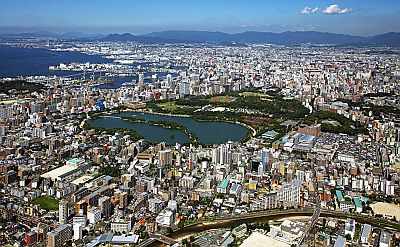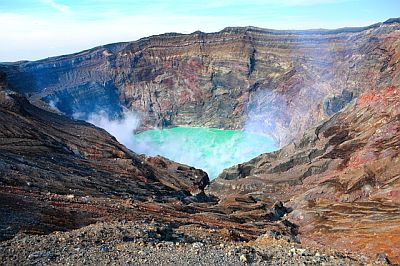Select units of measurement for the temperature and rainfall tables (metric or imperial).
Average weather, temperature, rainfall, sunshine hours
Kyushu has a
humid temperate climate, with quite mild winters and hot, rainy summers. Like the rest of Japan, the island is affected by the
monsoon circulation: in winter, cold currents from the northwest prevail, while in summer, they are replaced by warm, humid currents of tropical origin.
Kyushu is the southernmost of Japan's main islands, stretching between 31 and 34 degrees north latitude. About 170 km (105 mi) to the northwest is South Korea.
Rainfall in Kyushu is abundant, ranging from 1,700 to 2,500 millimeters (67 to 98 inches) per year in the plains. There is no dry season, although winter is the least rainy season.
The rainiest months are June and July, that is, the beginning of the rainy season due to the summer monsoon (the period called
Baiu), which in the southwest of Japan is particularly felt: sometimes the rains can be torrential. The southern coast is particularly rainy, especially in June: in Kagoshima, rainfall exceeds 500 mm (20 in) per month!
In
winter, the average temperature in January goes from 6/7 °C (43/45 °F) on the north-central part (see
Kitakyushu,
Fukuoka,
Nagasaki,
Kumamoto) to 9 °C (48 °F) on the south coast (see
Kagoshima).
In winter, there can be
cold periods, during which the temperature approaches freezing, and there can also be snowfall, although usually light.
On colder nights, the temperature drops a few degrees below freezing. The coldest records are generally of -7/-8 °C (18/19 °F), and locally of -10 °C (14 °F).
In
summer, the average for August, the hottest month, ranges from 28 °C (83.5 °F) at the northern tip (see Kitakyushu), to 29 °C (84 °F) in the center (see Kumamoto), to 29.5 °C (85 °F) in the south (see Kagoshima).
During
heat waves, the temperature can reach 37/38 °C (99/100 °F), and locally 40 °C (104 °F) in the inland areas.

In Fukuoka, located in the northern part of the island, the average temperature ranges from 6.5 °C (43.5 °F) in January to 28.5 °C (85 °F) in August.
Fukuoka - Average temperatures (1991-2020) |
| Month | Min | Max | Mean |
|---|
| January | 3.1 | 9.6 | 6.4 |
|---|
| February | 3.8 | 10.8 | 7.3 |
|---|
| March | 6.8 | 14.2 | 10.5 |
|---|
| April | 11.4 | 19.3 | 15.4 |
|---|
| May | 15.9 | 24 | 19.9 |
|---|
| June | 20.4 | 27 | 23.7 |
|---|
| July | 24.6 | 30.8 | 27.7 |
|---|
| August | 25.1 | 32.1 | 28.6 |
|---|
| September | 21.2 | 28.2 | 24.7 |
|---|
| October | 15.4 | 23.2 | 19.3 |
|---|
| November | 9.9 | 17.7 | 13.8 |
|---|
| December | 5 | 12 | 8.5 |
|---|
| Year | 13.6 | 20.8 | 17.15 |
|---|
Rainfall is abundant, amounting to 1,685 mm (66 in) per year, but, as mentioned, in other areas of the island it is even more abundant, reaching up to 2,500 mm (98 in) per year.
Fukuoka - Average precipitation| Month | Days |
|---|
| January | 75 | 11 |
|---|
| February | 70 | 11 |
|---|
| March | 105 | 11 |
|---|
| April | 120 | 11 |
|---|
| May | 135 | 10 |
|---|
| June | 250 | 13 |
|---|
| July | 300 | 12 |
|---|
| August | 210 | 11 |
|---|
| September | 175 | 11 |
|---|
| October | 95 | 8 |
|---|
| November | 90 | 10 |
|---|
| December | 70 | 10 |
|---|
| Year | 1685 | 129 |
|---|
In this northern part of Kyushu, the sea temperature drops to 16 °C (61 °F) in winter, while in the southern part it only drops to 19 °C (66 °F). On both coasts, the sea is warm enough for swimming in summer, but on the southern coast, the sea is already quite warm in June.
Fukuoka - Sea temperature| Month |
|---|
| January | 17 |
|---|
| February | 16 |
|---|
| March | 16.5 |
|---|
| April | 17.5 |
|---|
| May | 19.5 |
|---|
| June | 22 |
|---|
| July | 25.5 |
|---|
| August | 27.5 |
|---|
| September | 26.5 |
|---|
| October | 24 |
|---|
| November | 22"> |
|---|
| December | 19.5 |
|---|
| Year | 21.1 |
|---|
In the interior, there are also
mountains. The highest peak on the island is Mount
Kujū, which reaches 1,791 meters (5,876 feet).

Here are the average temperatures of
Mount Aso, the largest active volcano in Japan. The mountain is 1,592 meters (5,223 feet) high, but the weather station is at 1,143 meters (3,750 ft).
Mount Aso - Average temperatures (1991-2020) |
| Month | Min | Max | Mean |
|---|
| January | -4.5 | 1.9 | -1.3 |
|---|
| February | -3.6 | 4 | 0.2 |
|---|
| March | -0.3 | 8 | 3.8 |
|---|
| April | 5 | 13.4 | 9.2 |
|---|
| May | 9.8 | 17.9 | 13.8 |
|---|
| June | 14 | 20 | 17 |
|---|
| July | 17.8 | 23.4 | 20.6 |
|---|
| August | 18.2 | 24.3 | 21.2 |
|---|
| September | 14.9 | 21.5 | 18.2 |
|---|
| October | 9 | 16.5 | 12.8 |
|---|
| November | 3.4 | 10.7 | 7 |
|---|
| December | -2.2 | 4.6 | 1.2 |
|---|
| Year | 6.8 | 13.9 | 10.35 |
|---|
Precipitation is very abundant, even more than in the plains. Heavy snowfall occurs in winter, although the rainiest season is by far the summer.
Mount Aso - Average precipitation| Month | Days |
|---|
| January | 94 | 9 |
|---|
| February | 133 | 9 |
|---|
| March | 216 | 12 |
|---|
| April | 230 | 12 |
|---|
| May | 273 | 12 |
|---|
| June | 713 | 17 |
|---|
| July | 634 | 16 |
|---|
| August | 348 | 15 |
|---|
| September | 287 | 12 |
|---|
| October | 134 | 9 |
|---|
| November | 122 | 9 |
|---|
| December | 87 | 8 |
|---|
| Year | 3270 | 140 |
|---|
Typhoons
Like the rest of Japan, the island of Kyushu can be hit by
typhoons, the tropical cyclones of the western Pacific.
Typically, typhoons occur from June to October, however, they are more frequent
from August to early October; the strongest ones have occurred in September.
The area most affected is the southern coast, directly exposed to southerly winds and storm surges from the Pacific.
Cherry blossoms
The cherry blossoming (
Sakura) in Kyushu typically occurs from
late March to early April, peaking around March 29-31 in much of the island, and a few days later in Kagoshima, in the south, where there is more rain and less sunshine. About 8-9 days pass between the start and the peak of the flowering.
The date of the bloom can vary by a few days, or even a week, earlier or later, depending on the year.